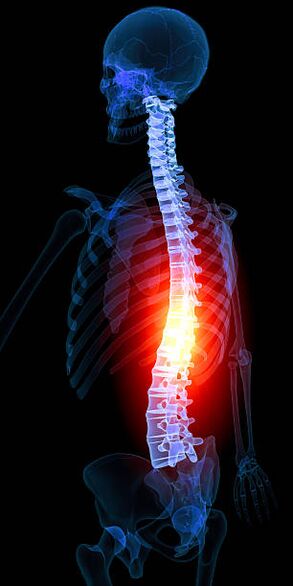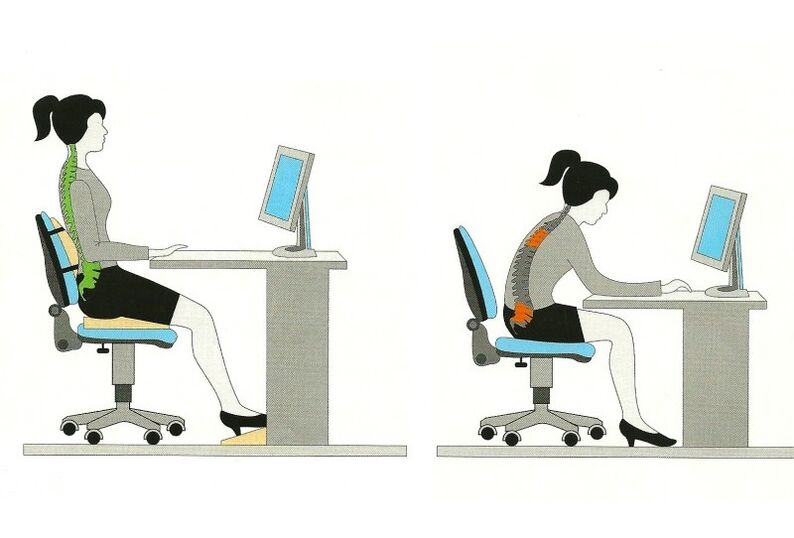There are many people who suffer from spinal diseases. These are old people, young boys and girls. Osteochondrosis of the thoracic spine is a disease of the spine characterized by degenerative-dystrophic changes; changes occur in the intervertebral discs located in the thoracic spine. Osteochondrosis of the thoracic spine is a type of osteochondrosis.
Symptoms

Knowing the symptoms of the disease, timely consultation with a doctor will help in a quick and effective treatment.
Symptoms of thoracic osteochondrosis:
- Decreased mobility of the thoracic region;
- Pain between shoulder blades, lower;
- Painful sensations in the chest, girdle character;
- Chest tightness (feeling of "creeping reptiles");
- dysfunction of the genital organs;
- Pain in the heart, liver, stomach.
It is difficult not to feel pain, to ignore it. If you do not have osteochondrosis, it is better to check the disease. You can't save time, you can't save money.
The most common symptoms of the disease are pain in the chest between the shoulder blades. Sudden movements, a change of position, a painful sensation (if you sit for a long time, then get up).
People with chest pain often suspect cardiovascular disease. Clinical research shows whether the suspicions are unfounded. The pain between the shoulder blades is familiar to everyone. If pain occurs, it is not necessarily a sign of osteochondrosis. Probably excessive tension of the vertebrae. It is no longer necessary to consult a doctor.
Cervicothoracic waist
Each part of the spine has sections that are problematic for the patient. Osteochondrosis of the cervicothoracic spine is often accompanied by neck pain and discomfort when turning the head. Osteochondrosis of the thoracic spine often affects the neck. Because the cervical vertebrae are considered mobile. Every second patient suffers from neck pain. There are three types of pain:
- Pain that occurs when the spine is loaded (if you lift something heavy);
- Occasional pain (dizziness);
- Persistent pain.
When a disease occurs, there is stiffness in movement, a forced position of the head. The sudden movement of the head is disturbing.
Reasons

The causes of osteochondrosis of the thoracic spine are similar to those of other parts of the spine with osteochondrosis. The main cause is back muscle spasms that put tension on the intervertebral discs. Causes of osteochondrosis of the cervicothoracic spine include lateral curvature of the spine, heavy loads and prolonged stay in one position.
Muscles prone to spasms constrict blood vessels. Blood supply, nutrition of intervertebral discs deteriorates. If you increase the load, the result is a disease of the spine. Lumbago often occurs in this part of the spine - a sharp painful sensation that occurs with a sharp movement.
Osteochondrosis of the thoracic spine is accompanied by difficulty breathing. With advanced disease, there are problems with the liver, stomach and heart. Spasm causes problems in the back and the rest of the body. Doctors do not recommend delaying the examination or treatment of osteochondrosis. The musculoskeletal system, the whole body suffers.
Don't overdo it
Exacerbation of osteochondrosis of the thoracic spine is manifested by sharp unbearable pain in the back, sometimes with pain in the side. Deep breathing, sharp movements increase pain. Climate change has a negative effect on the body. Patients often complain of back pain during coughing and at night.
There are two important elements in the structure of this spine. These are the upper and lower segments. If the upper segment is affected, the patient has chest, shoulder, stomach pain. If the lower segment is damaged, the sensitivity of the segment is reduced, and hip mobility is impaired.
Persistent pain changes its character from time to time - decreases, increases. The changes are influenced by the nature of the movements, the weather, the condition of the body.
Treatment
It is possible to treat the disease. There are many medications specifically designed to treat osteochondrosis. Treatment of thoracic osteochondrosis involves more than one type. Osteochondrosis will disappear with the help of drugs, lasers. The drug has an anti-inflammatory effect, relieves muscle tension. You should not choose your own medication. Medications will be prescribed by a doctor.
Medications have a negative effect on the gastric mucosa - the reason for a thorough examination of the patient. You should not rely on the choice of friends: everyone's body is individual, drug tolerance is individual. After the examination, the doctor will tell you what medications are needed for treatment.
Osteochondrosis is treated with laser. The procedure is more expensive than pills, but more effective. Tolerance is worth considering, as the examination may show that the type of treatment will not work. Doctors often resort to drugs, not laser treatment.
The spread of the disease
Osteochondrosis of the thoracic spine is common. Doctors distinguish it primarily by the frequency of osteochondrosis. Widespread osteochondrosis of the thoracic spine is treated. If the disease is complicated, treatment will be difficult.
To prevent complications, you should consult a doctor in time when the first symptoms appear. The complex nature of the disease, you can not wait until it heals itself. Self-medication will make the condition worse.
There are many clinics that will perform the examination and make a correct diagnosis. Do not be lazy to consult a doctor, get tested. Maybe you need help now. Do not put up with the pain, wait, postpone the visit to the doctors. The main thing in life is health. Your health, your loved ones.


















































